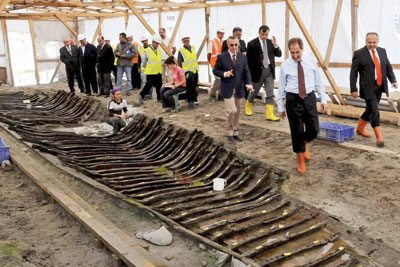Excavations during the Marmaray project had uncovered several archeological sites that would open a new chapter in the history of İstanbul, the Byzantine Empire and the world

The world’s largest sunken ship museum will be established in İstanbul thanks to finds from the Port of Theodosius dating back to the fourth century, which was discovered in Yenikapı during excavations in the Marmaray project, an undersea commuter tunnel linking Asia and Europe. Scientists studying the 36 sunken ships salvaged at the Yenikapı archeological site have been able to identify the trees used in building the vessels and their methods of construction.
Professor Ünal Akkemik from the forest engineering department at the forestry faculty of İstanbul University has said that the ships, dating back to the fourth century, were mainly made of oak. Noting that they are confident of uncovering the dates and methods of construction, Akkemik said: “So far 36 ships have been retrieved during the excavations, and I have conducted wood-related assays on 27 of them. We have completed our studies on 20 vessels. These ships were built mainly using oak trees as well as plane, chestnut, pine, cypress, common ash and beech. Some vessels were largely made of oak but had chestnut for the outer portions and oak for inner components. Others were mainly constructed using pine trees.”
Excavations during the Marmaray project had uncovered several archeological sites that would open a new chapter in the history of İstanbul, the Byzantine Empire and the world. These sites include secret passages, tombs, churches, works from the Bronze Age, ports, vessels and city walls that have been unknown to us until now. The archeological site at Yenikapı uncovered the ancient Port of Theodosius and with it, 36 sunken ships dating back from the fourth century were exposed to the light of day. Scientists at the laboratories of the forestry faculty at İstanbul University conducted several studies on samples from these ships to identify the trees used in their construction as well as their dates of construction. Akkemik said he has been analyzing the samples for two years. “The samples were sent to us after the sunken ships were salvaged. We conducted various tests and identified the materials used in building these ships. Four of these vessels were galleys. The rest were light commercial vessels,” he said.
First study conducted on ship no. 12
Akkemik notes that ship no. 12 from the Yenikapı archeological site was the first vessel he examined in the group. “The trees used to build this ship were oak, chestnut, common ash, beech and walnut. All of these except for walnut can be found in the Belgrade Forest [in İstanbul]. This ship was probably constructed in or near İstanbul. Hard and durable woods from oak trees were used for the skeleton. Although oak is common in Turkey, we don’t know whether the oak used in this ship was procured from Turkey or elsewhere. It may have been procured from Romania or Bulgaria. In addition to oak, other woods such as chestnut, plane, black pine, Turkish pine, stone pine, elm, cypress, horn beech, common ash, walnut, beech, alder, poplar and hophornbeam were also used. We have identified what types of wood were used in which parts of the vessels and for what purpose. Oak and broom trees from Sarıyer were common for wooden nails,” he said.
CHA

Leave a Reply